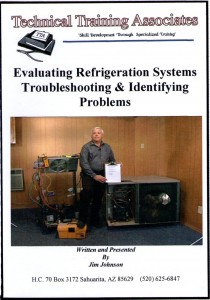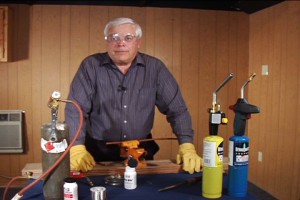In spite of the widespread availability and apparent reference to the pressure-temperature relationship, very few service technicians seem to use the P-T chart properly in diagnosing service problems.
The purpose of this article is to not only demonstrate the proper use of the pressure-temperature relationship, but to also illustrate how it can be used to thoroughly analyze a refrigeration or air conditioning system.
The System
Before getting into the use of the P-T card, let’s review briefly the refrigeration system and examine exactly how the pressure-temperature relationship can be applied.
The refrigerant in a refrigeration system will exist in one of the following forms: all liquid, all vapor, or a mixture of liquid and vapor. In a normal operating system (Figure 1) the highside contains refrigerant in all of the three conditions. The discharge line contains all vapor. The condenser where the vapor condenses into a liquid contains a mixture of liquid and vapor. The line between the condenser and the receiver usually contains all liquid, although it would not be abnormal for this line to also have some vapor mixed with the liquid. Inside the receiver there is a liquid level, and a mixture of liquid and vapor are present at this interface.
The liquid line leading from the receiver to the thermostatic expansion valve should contain all liquid. A sight glass or liquid indicator is frequently installed in the liquid line to assist in determining whether the liquid refrigerant is completely vapor-free.
The low side of the system will usually contain refrigerant in only two of the three forms that were listed previously. That is, the lowside will contain all vapor in the suction line, and a mixture of liquid and vapor from the outlet of the thermostatic expansion valve to nearly the outlet of the evaporator.
Saturated
It is important to remember that the pressure-temperature relationship as shown by a P-T card is typically only valid when there is a mixture of refrigerant liquid and vapor. This condition is known as “saturated.” Saturation can range from saturated liquid with a bubble of vapor present to saturated vapor with a drop of liquid present and all conditions in between.
There are only three places in the normally operating refrigeration system where the P-T relationship can be guaranteed with certainty — the evaporator, the condenser, and the receiver. This means that if we are able to determine the pressure at any of these points, we can easily determine the saturation temperature by merely finding the pressure on a P-T card and reading the corresponding temperature. Conversely, if we can accurately measure the temperature at these three locations, we can also determine the saturation pressure from the P-T relationship by finding the pressure corresponding to the temperature that we have measured.
At the points in the system where only vapor is present, the actual temperature will typically be above the saturation temperature. In this case, the difference between the measured temperature and the saturation temperature at the point in question is a measure of superheat. If these temperatures are the same, the amount of superheat would be zero. With zero superheat, liquid may be present because a saturated condition exists.
Where it is known that only liquid is present such as in the liquid line, the measured temperature will be somewhere at or below the saturation temperature. In this case, the difference between the measured temperature and the saturation temperature is a measure of liquid subcooling. Again, it is possible to find that the actual measured temperature is equivalent to the saturation temperature, in which case the amount of subcooling would be indicated as zero. With zero subcooling, vapor may be present because the refrigerant is at saturation.
Refrigerant Condition
In a normally operating system running on HFC-134a (Figure 2), we can gain some insight into the condition of the refrigerant at the various points. The measured temperature at the evaporator inlet is 19°F. A gauge installed at this point indicates a pressure of 18 psig. Now, 18 psig on the P-T card indicates a temperature of 19°. It might also be said that the superheat is zero and the subcooling is zero. Therefore, the refrigerant is at saturation, or in other words, at the boiling point. This is what we should expect since, when refrigerant liquid and vapor are present together, the P-T relationship will hold true.
A gauge installed in the suction line measures 16 psig. If there were a mixture of liquid and vapor at this point, the measured temperature would be the same as the saturation temperature or 16°F. However, our actual measured temperature in this case is 27°. The amount of superheat in the vapor is the difference between the measured temperature of 27° and the saturation temperature (according to the P-T chart) of 16°. Therefore, the superheat is 11°.
If we also measure 16 psig at the compressor inlet with the measured temperature of 47°, our superheat in this case would be 31°, calculated by subtracting the saturation temperature equivalent to 16 psig (16° from the measured temperature of 47°).
Let’s now examine the gauge we have installed midway in the condenser which reads 158 psig. According to the P-T card, the saturation temperature will be 115°. This is the temperature that we would be able to measure if we placed a thermocouple in the refrigerant at the point where it is changing from a vapor to a liquid. At this point, there is no difference between the measured temperature and the saturation temperature. It might also be said that the superheat is zero and the subcooling is zero. Therefore, the refrigerant is saturated, or in other words, at the boiling point.
In our example we also measure 158 psig at a discharge line of the compressor. The measured temperature here is 200°. Calculating the superheat in the same way as it was done on the suction line (difference between measured temperature and saturation temperature), it is determined that the superheat is 85°.
Inside the receiver there is no subcooling at the liquid and vapor interface. The reason is that when liquid refrigerant and vapor exist together, the refrigerant is saturated and must obey the P-T relationship. In our example the measured pressure in the receiver is 146 psig; the refrigerant at the surface of the liquid level in the receiver must therefore be at 110°.
Leaving the receiver a solid column of liquid is present. Subcooling of the refrigerant can take place by lowering its temperature with the use of liquid suction heat exchangers, subcoolers, or from lower ambient temperatures surrounding the line. Subcooling is a lowering of a temperature below the saturation point or boiling point.
In our illustration (Figure 2) subcooling of 5° and 2° has been determined at two points. Of course, it is important to maintain some liquid subcooling in the liquid line to prevent flash gas from forming in the liquid line and entering the thermostatic expansion valve.
With the use of a P-T card, we should be able to determine the condition of the refrigerant at any point in the system by measuring both the pressure and the temperature and observing the following rules:
• Liquid and vapor are present together when the measured temperature and pressure correspond to the P-T relationship. (It is theoretically possible to have 100 percent saturated liquid or 100 percent saturated vapor under these conditions. But practically speaking in an operating system, it should be assumed that some liquid and some vapor are present together under these conditions.)
• Superheated vapor is present when the measured temperature is above the saturation temperature corresponding to the P-T relationship. The amount of superheat is indicated by the difference.
• Subcooled liquid is present when the measured temperature is below the saturation temperature corresponding to the P-T relationship. The amount of subcooling is represented by the difference.
Limitations
Since it is not possible to locate gauges on as many places in a system as we might wish, we must oftentimes make deductions and assumptions when dealing with an actual system.
As an example, we would normally assume that the 158 psig read on the gauge installed at the compressor discharge line is also the pressure that exists in the condenser. That is, we assume that there is no pressure loss of any consequence between the compressor discharge and the condenser. With this reasoning, we arrive at a condensing temperature of 115°. If an undersized discharge line or other restrictions are suspected, we cannot make this assumption and other pressure taps may be necessary to have a more accurate measurement.
It is also common practice to assume that the pressure measured at the suction service valve of the compressor is the same pressure that exists at the outlet of the evaporator at the expansion valve bulb location. This is particularly true on close-coupled systems where it has been determined that the suction line is of the proper size. By making this assumption, we can determine the expansion valve superheat without installing an additional pressure tap at the bulb location. However, to eliminate any doubt as to the amount of suction line pressure drop and to be absolutely precise in measuring superheat, a gauge must be installed in the suction line at the bulb location.
Care must be taken to make a reasonable allowance for pressure drops within the system. Excessive pressure drops can be detected by applying the principles of the P-T relationship. As an example, with gauges installed only at the suction and discharge of the compressor and reading as indicated, a significant pressure drop through the evaporator would be indicated by a high temperature of, say, 50° measured at the evaporator inlet which would correspond to a pressure at that point of approximately 45 psig. That would mean that there is a pressure drop of 29 psi from the evaporator inlet to the compressor inlet (45-16=29).
While this would be considered excessive on a single-circuit evaporator, it should be remembered that on multicircuit evaporators there will be a pressure drop through the refrigerant distributor assembly. A pressure drop through the distributor assembly on R-134a may be in the vicinity of 25 psi. This means that with the use of a refrigerant distributor, a measured temperature between the outlet of the thermostatic expansion valve and the inlet of the distributor of approximately 50°F would not be abnormal.
Noncondensables
The proper use of the P-T relationship can be helpful in discovering the presence of air or other noncondensable gases in the system. These undesirable gases will accumulate in the condenser and raise the condenser pressure above normal. With the condenser isolated and brought to ambient temperature, the condenser pressure should be determined. If the condenser pressure is higher than the saturation pressure that corresponds to the ambient temperature, noncondensables may be present in the condenser.
Summary
With an understanding of the refrigerant pressure-temperature relationship, the widely available P-T card is a valuable tool. A P-T card, along with accurate gauges and thermometers, allows us to determine at any point in the system if the refrigerant is saturated, subcooled, or superheated. This is very important in properly diagnosing system problems.
This material was provided by Sporlan, a division of Parker Hannifin Corp. For more information, go to www.sporlan.com.
Publication date: 1/21/2013








